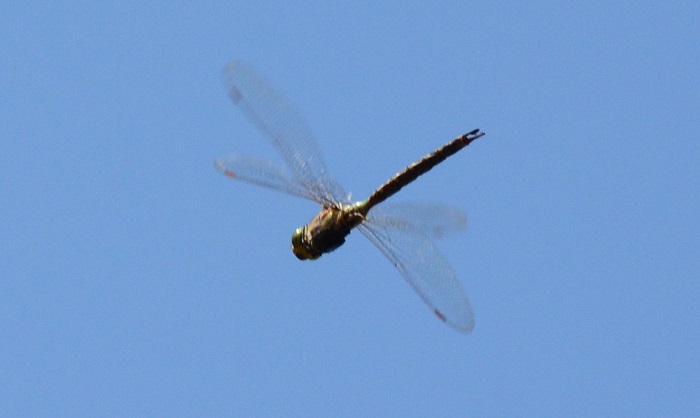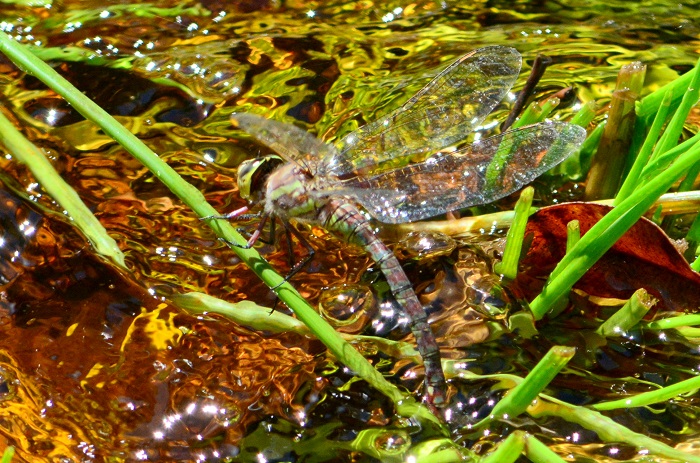Cover photo by Gert Bensch.
Find the Stream Hawker in the FBIS database (Freshwater Biodiversity Information System) here.
Family Aeschnidae
Identification

Lekgalameetse Nature Reserve, Limpopo
Photo by Vaughan Jessnitz
Large size
Length attains 64mm; Wingspan reaches 91mm.
The Stream Hawker is only likely to be mistaken for the females of other Hawker species, as they lack the blue markings of their respective males. These are Zosteraeschna minuscula (Friendly Hawker), Zosteraeschna usambarica (Forest Hawker) and Anaciaeschna triangulifera (Evening Hawker).
Both sexes of the Stream Hawker can be told apart from the above mentioned species by the diagnostic yellow patch with a central black dot on the forehead.
Click here for more details on identification of the Stream Hawker.

Lake Naverone, KwaZulu-Natal
Photo by Ryan Tippett
Habitat
The Stream Hawker inhabits streams and rivers. It favours fast-flowing stretches with rocks and fringing vegetation such as grass and bushes. The Stream Hawker is most often found in hilly or mountainous regions. It occurs in both open and more wooded environs. Pinheyschna subpupillata occurs up to 2000m above sea level.

Photo by Ryan Tippett
Behaviour
The Stream Hawker is an active, aerial species that spends most of its time in flight. It patrols swiftly, back and forth along a chosen stretch of river. The Stream Hawker periodically rests on nearby bushes or by clinging to the sides of boulders. It most often hangs vertically when at rest.
The Stream Hawker is most active from September to April (see Phenology below).

Marloth Nature Reserve, Western Cape
Photo by Ryan Tippett
Status and Conservation
The Stream Hawker is fairly common where it occurs. It is listed as of Least Concern in the IUCN Red List of Threatened Species.

Dassieshoek Nature Reserve, Western Cape
Photo by Ryan Tippett
Distribution
The Stream Hawker is near-endemic to South Africa, where it is found in mid to high altitude regions from the Western Cape to Limpopo. It is also found in the Eastern Highlands of Zimbabwe and adjacent Mozambique.

Dassieshoek Nature Reserve, Western Cape
Photo by Ryan Tippett
Below is a map showing the distribution of records for Stream Hawker in the OdonataMAP database as at February 2020.

Below is a map showing the distribution of records for Stream Hawker in the OdonataMAP database as of December 2024.

The next map below is an imputed map, produced by an interpolation algorithm, which attempts to generate a full distribution map from the partial information in the map above. This map will be improved by the submission of records to the OdonataMAP section of the Virtual Museum.


Ultimately, we will produce a series of maps for all the odonata species in the region. The current algorithm is a new algorithm. The objective is mainly to produce “smoothed” maps that could go into a field guide for odonata. This basic version of the algorithm (as mapped above) does not make use of “explanatory variables” (e.g. altitude, terrain roughness, presence of freshwater — we will be producing maps that take these variables into account soon). Currently, it only makes use of the OdonataMAP records for the species being mapped, as well as all the other records of all other species. The basic maps are “optimistic” and will generally show ranges to be larger than what they probably are.
These maps use the data in the OdonataMAP section of the Virtual Museum, and also the database assembled by the previous JRS funded project, which was led by Professor Michael Samways and Dr KD Dijkstra.



Marloth Nature Reserve, Western Cape
Photo by Ryan Tippett
Further Resources
The use of photographs by Gert Bensch and Vaughan Jessnitz is acknowledged. All other photographs by Ryan Tippett.
Stream Hawker Pinheyschna subpupillata (MacLachlan, 1896)
Other common names: Spruitjieventer (Afrikaans)
Recommended citation format: Loftie-Eaton M; Navarro R; Tippett RM; Underhill L. 2025. Stream Hawker Pinheyschna subpupillata. Biodiversity and Development Institute. Available online at https://thebdi.org/2020/05/20/stream-hawker-pinheyschna-subpupillata/
References: Tarboton, M; Tarboton, W. (2019). A Guide to the Dragonflies & Damselflies of South Africa. Struik Nature.
Samways, MJ. (2008). Dragonflies and Damselflies of South Africa. Pensoft
Samways, MJ. (2016). Manual of Freshwater Assessment for South Africa: Dragonfly Biotic Index. Suricata 2. South African National Biodiversity Institute, Pretoria

Ruiterbos, Western Cape
Photo by Ryan Tippett

